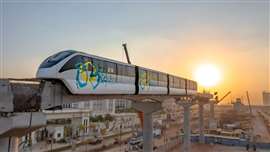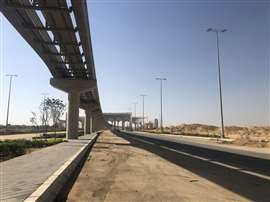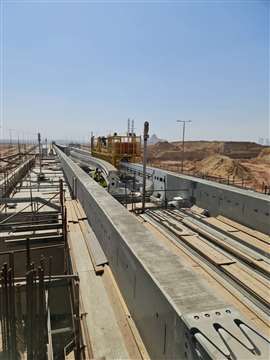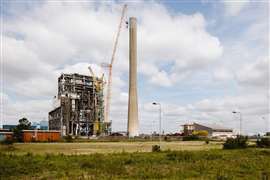Read this article in Français Deutsch Italiano Português Español
Masterminding the construction Cairo’s $5.5bn monorail megaproject
28 March 2024
Cairo’s US$5.5bn Monorail is set to reduce congestion in the Middle East’s largest city and connect it with a new administrative centre in the desert . Waleed Abdel-Fattah at project manager Hill International tells Lucy Barnard about the construction so far.
It may be the holy month of Ramadan in Egypt when traditionally everyone slows down, but around Cairo, workers are busy putting the finishing touches on the city’s new 100km monorail line which bisects the ancient city and stretches out into the desert to the east and west.
It’s hard to miss the Cairo monorail, a US$5.5bn megaproject which has been under construction across the capital since 2019. Its elevated concrete posts currently stand out high above many of the city’s crowded streets stretching as far as the eye can see.
 A section of the Cairo Monorail under construction in February 2024. Photo: Hill International
A section of the Cairo Monorail under construction in February 2024. Photo: Hill International
To some, like Waleed Abdel-Fattah, president for the MENA region of US-based project manager Hill International, the hi-tech driverless system stands as a promise of cheap, quick, environmentally-friendly mass transport. It promises to help the largest city in the Middle East reduce its carbon footprint and enable its 10 million people to get about more easily, he says.
“By doing this we’re going to be saving so many people from travelling by car every day, from using regular private cars or semi-public transportation for over 100 kilometers.
“Just by itself it’s going to decrease the city’s carbon footprint and also create a modern and sustainable new city,” he asserts.
Certainly, Cairo’s traffic congestion is legendary, with 3.3 million cars, buses, taxis and minibuses travelling the streets daily, many of which often end up backed up in gridlocks which can grind well into the night and cause headaches for the city’s 10 million residents.
The monorail itself is in fact two pre-cast elevated concrete guideways which start 7.5 miles away from each other and are linked by the Cairo underground Metro system. A first branch east of the River Nile (EON), being built by Egyptian contractor Orascom, runs from Stadium Metro station in Nasr City to the north east of central Cairo for 56.5km to the New Administrative Capital where most of Egypt’s government ministries are being transferred. A second branch west of the River Nile (WON), being built by Egypt-based Arab Contractors, will run from Gameat el Dowal in the west of the city for 45km to New October City in the Giza Governorate. The network has no track, but the rubber tyres of its trains run directly on the concrete guideways while electric power to propel the train is supplied by a third rail inside the concrete.
Progress against a challenging backdrop
In March, the International Monetary Fund (IMF) agreed to bail Egypt out to the tune of US$8bn – up from an initial US$3bn announced in October 2022 - after the government finally agreed to devalue its currency by 35%, the fourth devaluation in two years.
 The Cairo Monorail approaches the New Administrative Capital Gate. Photo: Hill International
The Cairo Monorail approaches the New Administrative Capital Gate. Photo: Hill International
According to a statement from the IMF, as part of the emergency loan agreement, Egypt’s government has had to agree to reduce its outgoings on some of its massive construction programme, although the fund did not say which projects were likely to be affected.
Abdel-Fattah says that work on the monorail project is continuing despite the economic crisis and that Hill and all the other contractors on the project have been paid.
“We never stopped work on the monorail,” he says. “The monorail is not one site, it’s 100 kilometers of sites across the city. They schedule the work depending on the actual requirements. The client has been very keen to finalise the project so the will of everybody has been to complete the project which has been helpful.”
Nonetheless, the monorail has hit a number of delays, not least the covid pandemic and the global supply chain problems which followed it.
“At the beginning the contractor did a good job to get a lot of the major equipment supplied in 2020-21,” says Abdel-Fattah. “However, we had a few problems with some of the steel for the cable tracks and things like that. When you need to supply these things for 100km, it’s a lot.”
Abdel-Fattah says that the main stalling point has been disagreement about the route, problems with compulsorily purchasing the land required along the route and getting sign-off from all the parties involved.
Coordinating the route
“It’s not like a railway where you have a few massive stations. There’s a need to better coordinate,” he says. “There is a university here, there’s a shopping area there, there’s an innovation area and the line needs to be close to this landmark or hospital. It’s an ongoing process. You have to look at basic enhancement and ensure that you are not going miles away but also make sure that you control the cost and time as well.”
Street closures resulting from the monorail’s construction over the last four years have been a grumble of many of the city’s 10 million residents.
“We caused a lot of bottlenecks and a lot of traffic issues,” says “It has been a logistical nightmare. We were lucky that we were working on the big main streets. But even then, we had to pre-cast the [85-100ft long guideway] beams in yards at the ends of the line and then transport them by truck between midnight and three every morning.”
 Works on the elevated concrete guideway. Photo: Hill International
Works on the elevated concrete guideway. Photo: Hill International
“Then we had to use a mobile crane to lift the 80-100 tonne beams making sure there was no deflection because they are very sensitive. The mobile cranes take up a lot of space and they block the roads. And then you have your own staff and security and often scaffolding there too. And of course, you have two beams between each column – and we have to do this over a distance of 100km.”
Although the project was initially due to be completed in May 2022, Abdel-Fattah says that the East of Nile (EON) line, which is being built by Orascom as part of a US$780m contract, will now open in summer 2024. Meanwhile, the West of Nile (WON) section, which is being built by Arab Contractors as part of a US$560 million contract, is unlikely to begin operation until Q1 2025. French rolling stock manufacturer Alstom is leading the consortium which is responsible for designing and building the lines and then operating them for the next 30 years.
And, for Abdel-Fattah, the Cairo monorail offers an opportunity for other cities across the Middle East and Africa to upgrade their public transport networks too.
“In Egypt it’s a change in culture because everyone is still more into taking a cab. But people will get used to it. Once they find it is a decent transport that will take you back and forth in a clean way with accurate timing, they will start using it,” he says. “Representatives from a lot of countries are coming here, visiting us and looking at the sites and once there is a live example in the MENA region there will be more. A lot of feasibility studies are happening now in the region off the back of this project.”
Egypt’s ambitious infrastructure and megaproject spend
For many Egyptians, the elevated monorail track, visible across the city, also stands as a symbol of an ambitious programme of megaproject and infrastructure spending paid out by President Abdel Fattah al-Sisi since he came to power in 2013.
That programme also includes three high-speed rail lines, an expansion of the Suez Canal, an extensive road building programme and the construction of a new capital city in the desert.
Indeed, the main purpose of the new rapid transit system is to link Cairo with the 700 square kilometre administrative and financial capital city, currently under construction at the end of the line, designed to take the pressure off the ancient capital and provide a modern, masterplanned seat of government and homes for as many as 7 million people.
“The new capital is going to be modern and sustainable,” said Abdel-Fattah. “It’s going to be a great addition to the city. It’s already happening now. All the ministries have been moving there. I’d say most of the meetings we have now are happening there rather than in Downtown Cairo. So, it needs a modern and sustainable public transportation system.”
Sisi has made it clear that lavish megaproject spending is also a useful tool in maintaining social stability by providing much-needed jobs.
But his ambitious infrastructure spending comes at the same time that the country is grappling with ballooning debt. Since early 2022, a shortage of foreign currency, triggered by Russia’s invasion of Ukraine and exacerbated by war in neighbouring Gaza, has plunged the country into its worst economic crisis in decades. Inflation hit a record high of nearly 40% last summer with the cost of some basic food items quadrupling. In February, repayments on the country’s external debt were forecast to reach US$29bn in 2024, equating to 8% of Egypt’s GDP.
In March, the IMF agreed to bail Egypt out to the tune of US$8bn – up from an initial US$3bn announced in October 2022 - after the government finally agreed to devalue its currency by 35%, the fourth devaluation in two years. It’s still not clear how this could impact Egypt’s wide-ranging infrastructure projects.
|
STAY CONNECTED


Receive the information you need when you need it through our world-leading magazines, newsletters and daily briefings.
CONNECT WITH THE TEAM











